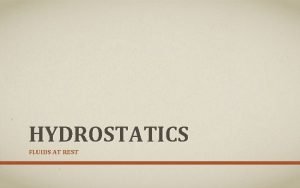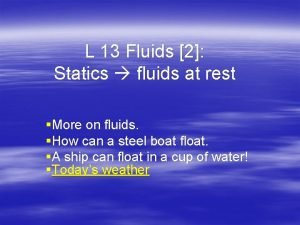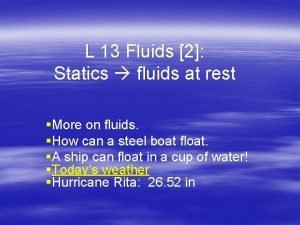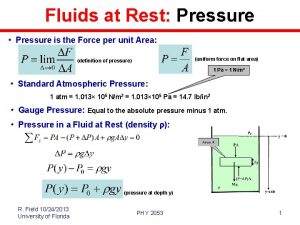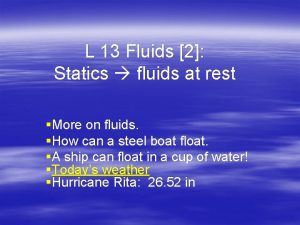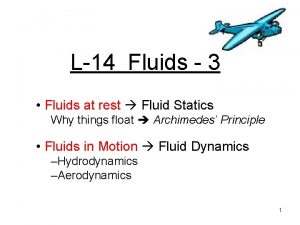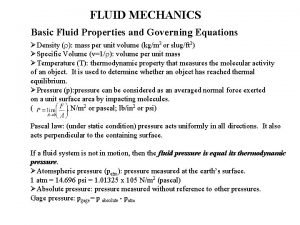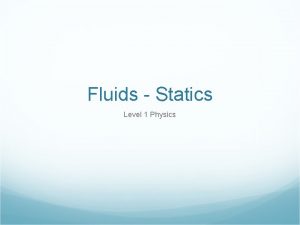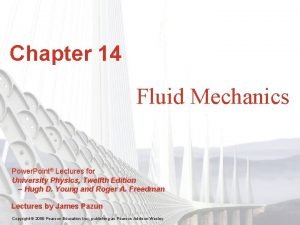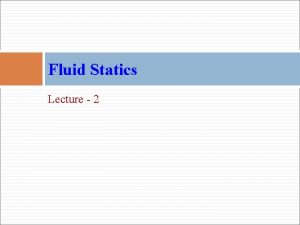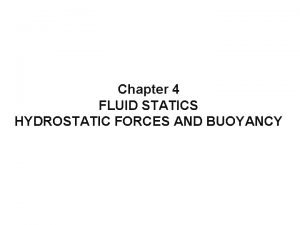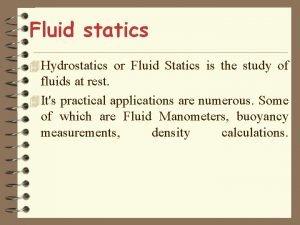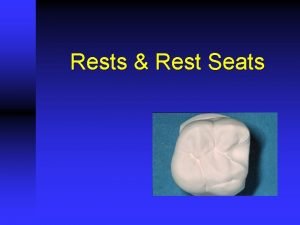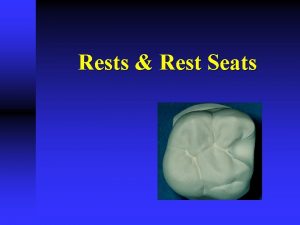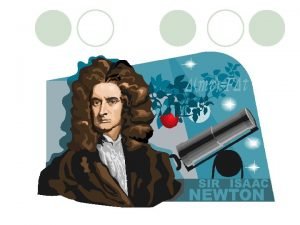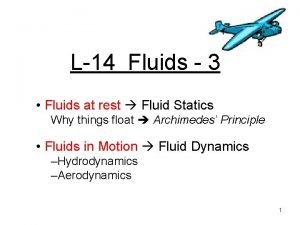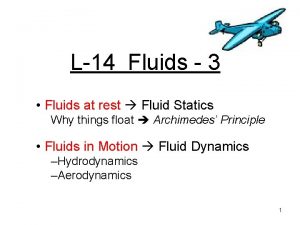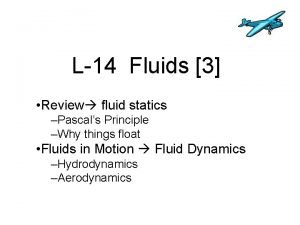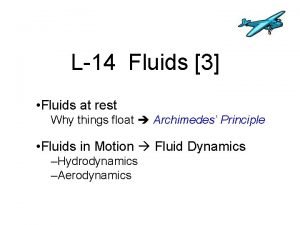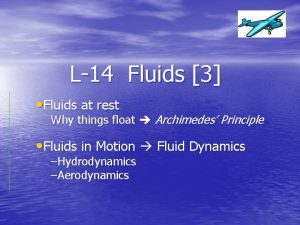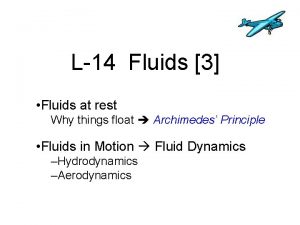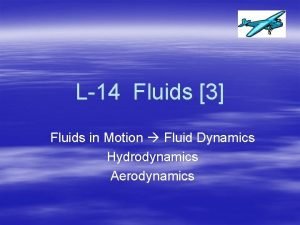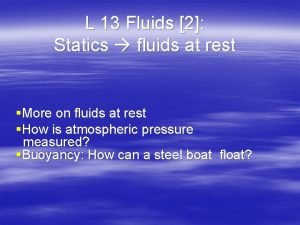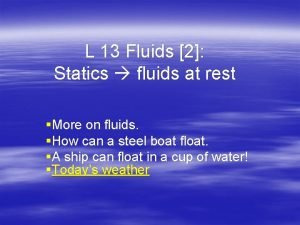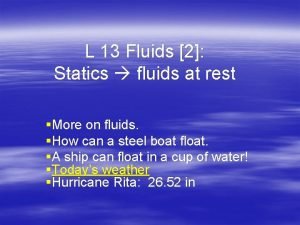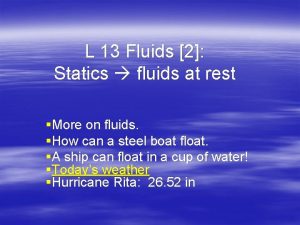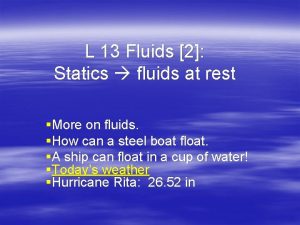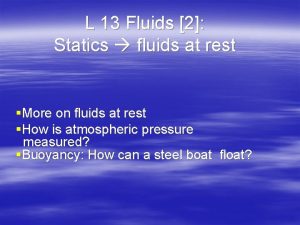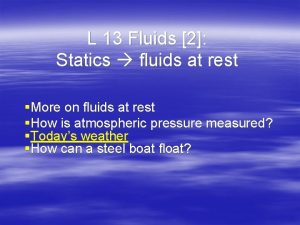L14 Fluids 3 Fluids at rest Fluid Statics
![L-14 Fluids [3] • Fluids at rest Fluid Statics Why things float Archimedes’ Principle L-14 Fluids [3] • Fluids at rest Fluid Statics Why things float Archimedes’ Principle](https://slidetodoc.com/presentation_image_h/31059c5ffac4ff5eb1a3ec76916b561e/image-1.jpg)























- Slides: 24
![L14 Fluids 3 Fluids at rest Fluid Statics Why things float Archimedes Principle L-14 Fluids [3] • Fluids at rest Fluid Statics Why things float Archimedes’ Principle](https://slidetodoc.com/presentation_image_h/31059c5ffac4ff5eb1a3ec76916b561e/image-1.jpg)
L-14 Fluids [3] • Fluids at rest Fluid Statics Why things float Archimedes’ Principle • Fluids in Motion Fluid Dynamics –Hydrodynamics –Aerodynamics

Example: What does 1 liter (about a quart) of water weigh? • 1 liter = 1000 cm 3 • Density of water = 1 g/cm 3 = 1000 kg/m 3 • Mass of 1 liter of water = 1 g/cm 3 x 1000 cm 3 = 1000 g = 1 kg • W = mg = 1 kg x 9. 8 m/s 2 = 9. 8 N ( 10 N) = 2. 2 pounds (1 gallon 8 pounds) • Water weighs about 10 N/liter

Archimedes’ Principle • pressure difference: P= Pbottom – Ptop = w g h A h FB WO OBJECT volume = h A = V • buoyant force: FB = P x A = ( w g h) A = w g V = ( w V)g = mw g = Ww = weight of water displaced by the object (Archimedes Principle) density = w, kg/m 3 • Water weighs 10 N per liter, so for every liter of water displaced, there is a buoyant force of 10 N mass of displaced water = mw = w V • The object floats to a level where enough water is displaced, so that weight of displaced FB = W O water = Ww = mw g

Archimedes principle in action The buoyant force on an object in a fluid equals the weight of the fluid which it displaces. Anything less dense than water will float in water weighs 10 N/liter each liter of displaced water provides 10 N of buoyant force –helium balloons: (density of He = 0. 18 kg/m 3) –hot air balloons: the density of hot air is lower than the density of cool air so the weight of the cool air that is displaced is larger than the weight of the balloon (this is also why hot air in a room rises) –Steel (8 g/cm 3) floats in mercury (13. 6 g/cm 3)

Will it float? • The buoyant force is always there whether the object floats or not • The object will float if the buoyant force is big enough to support the object’s weight • The object will displace just enough water so that the buoyant force = its weight • If it displaces as much water as possible and this does not equal its weight, it will sink. • Objects that have a density less than water will float- when fully submerged, they weigh less than the water, so the water supports them

Floating objects lighter object heavier object too heavy The weight of displaced water is less than the weight of the object

example problem • An object having a volume of 6 liters and weighing W = 30 N is placed in a tank of water. What will happen? Will it sink? Will it float? What fraction of its volume will be submerged if it floats? • If the object were completely submerged, the buoyant force would be FB, max = 10 N/liter x 6 liters = 60 N • thus, the object will float with half of its volume submerged, so that FB = W = 30 N W FB

Water is weird stuff! Maximum density at T = 4 C

Why does ice float? • Water, the most plentiful substance on earth is also one of the most unusual in its behavior in that it expands when it freezes. • Since it expands, the density of ice is slightly less than the density of water (958 kg/ m 3 as compared to 1000 kg/ m 3 for water). So the part of the iceberg above the surface is less than 10 % of the total volume.

Ice cube in water - will it spill over? ice cube When the ice cube melts will: 1) the water spill out, or 2) the water level stay the same, or 3) the level go down ? ? Answer: The level stays the same. Ice is less dense than water, so that the volume occupied by the ice is exactly big enough to hold the volume of melted water that was not submerged!

Fluid Flow • The physics of fluid flow was worked out by Daniel Bernoulli • He was born in Switzerland in 1700 • He was one of 5 brothers and came from a large family of mathematicians and scientists.

fluid flow example – leaky cup Pressure increases with depth, so the speed of water leaking from the bottom hole is larger than that from the higher ones.

How do we measure fluid flow? • We see how much comes out in some time interval • Time how long it takes to fill the bucket, say 30 seconds • the flow rate is then 1 bucket say per 30 seconds • in other words volume per unit time • gallons per min (gpm), liters/s, cubic feet per min (cfm), gpf, or m 3/s volume flow rate

Volume flow rate • If the water comes out of a tube of cross sectional area A with a flow speed u the volume flow rate = u A (m/s m 2) m 3/s • To measure u just see how long it takes to fill a gallon jug from a hose and measure the diameter of the hose.

Mass flow rate • We could also measure how much mass comes out per unit time – kg/s for example • if you are using a fluid of density coming out of a hose of cross sectional area A with speed v the mass flow rate is • mass flow rate = u A

What makes water flow? • gravity • by placing the water up high the pressure at the bottom is high enough to supply water to all parts of town that are lower than the tower Stanton, IA Montgomery Co.

Pressure differences P 2 P 1 a pressure difference must be maintained across the ends of the pipe to push the water along. P 2 must be greater than P 1 this pressure difference can be set up by a water pump.

Water does not disappear! • If water goes in one end of a pipe it must come out the other end (if there are no leaks of course. Sounds obvious, but it has a number of interesting consequences! This applies to pipes that have constrictions also. v 1, A 1 v 2, A 2

Principle of the continuity of flow • since whatever goes in must come out we have that the incoming flow rate – outgoing flow rate or • v 1 A 1 = v 2 A 2 (continuity principle) • thus the fluid in the narrow part of the tube must flow FASTER that the fluid on the left. • Cardiologists use this to determine if arteries might be clogged.

Other examples - the nozzle effect • you use this principle whenever you hold your finger over the end of the hose to make the water spray farther.

An amazing thing about moving fluids • The pressure in a moving fluid is less than the pressure in a fluid at rest! this is Bernoulli's principle. • Where a fluid moves faster its pressure is lower, where it moves slower, its pressure is higher. • As we will see, this is the principle that allows airplanes to fly

The Venturi Meter


Atomizers (perfume spritzers) Using the Bernoulli effect, fine droplets of liquid are formed with this device
 Fluid statics deals with
Fluid statics deals with P1-p2
P1-p2 Fluids at rest
Fluids at rest Fluids at rest
Fluids at rest Fluids at rest
Fluids at rest Fluids at rest
Fluids at rest Examples of fluid statics
Examples of fluid statics Fluids at rest
Fluids at rest Heavy object
Heavy object Fluids at rest
Fluids at rest Pressure gradient fluid mechanics
Pressure gradient fluid mechanics Pressure vs depth equation
Pressure vs depth equation Fluid kinematics - ppt
Fluid kinematics - ppt Examples of fluid statics
Examples of fluid statics A 4m-long quarter-circular gate of radius 3 m
A 4m-long quarter-circular gate of radius 3 m Water bed
Water bed Law of hydrostatics
Law of hydrostatics Canine rest seat preparation
Canine rest seat preparation Lingual rest
Lingual rest Object at rest stays at rest
Object at rest stays at rest Rest seat
Rest seat Ghost cries purgatorium
Ghost cries purgatorium Transcellular fluid
Transcellular fluid Movement of body fluids
Movement of body fluids Bioimpedância
Bioimpedância


